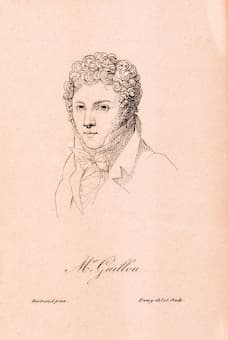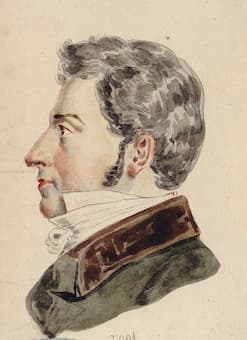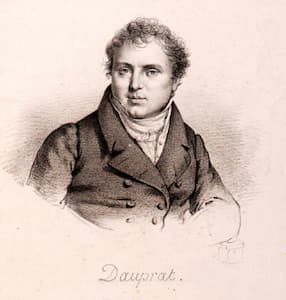
C. Constans after Counis: Anton Reicha, 1815
Antonín Rejcha, later Antoine or Anton Reicha (1770-1836) came from a hard childhood. His father, Simon, the town piper of Prague, died when he was 10 months old and at age 11, he ran away from his mother who couldn’t care for him properly, and took refuge with his grandfather. Eventually, he lived with his uncle Josef, a cellist at the court of Oettingen-Wallerstein. His uncle was also the concertmaster for the court orchestra and under his uncle’s guidance, the young Antonín learned to play the flute, the violin, and the piano and by age 15 was a member of the Elector’s orchestra in Bonn, playing flute and violin, where his uncle was now concertmaster.

Jacques-Noël-Marie Frémy after Vincent Bernard:
Joseph Guillou, 1820
In Bonn, he became friends with the organist and viola player in the orchestra, the young Beethoven. They both took composition lessons from Christian Neefe and in 1792, both students were offered the chance for study with Haydn in Vienna. Beethoven accepted but Reicha stayed with his uncle until 1794 when Napoleon’s troops overran the city. Antonín went first to Hamburg then to Paris but the bad climate in Hamburg and the political situation in Paris soon drove him to join Beethoven in Vienna. Napoleon’s arrival in Vienna drove Rejcha to return to Paris where he Frenchified his name to Antoine Reicha and set himself up as a music teacher. Among his pupils were composers who were going to be the stars of the Romantic period: Berlioz, Liszt, Franck, and Gounod. In 1818, his reputation was such that he was appointed to teach composition at the Paris Conservatoire.

Gustave Vogt
The publication in 1817 of his first set of wind quintets created ‘a sensation throughout Europe,’ as Reicha was to write in his autobiography. These works for flute, oboe, clarinet, horn, and bassoon took five instruments that were viewed as ‘opposite-toned,’ and created a new sound. Through his compositional style and arrangements, and use of rich harmonies and effective scoring, Reicha created a new genre that was immediately popular.
The particular ensemble that Reicha was writing for included 4 professors from the Paris Conservatoire. The flute part was written for Joseph Guillou, the clarinet for Jacques-Jules Bouffil (the only member not to hold a position at the conservatoire), the oboe part for Gustave Vogt, who was noted for the beauty of his sound, the horn part for Louis-François Dauprat, and the bassoon part for Antoine Henry. All the players except the bassoonist had studied composition with Reicha.

Louis-François Dauprat, 1800
His first quintets were the six quintets of his Op. 88. The first 2 were written in 1811 and the final 4 in 1817; this was followed by the Op. 91 quintets in 1818, the Op. 99 quintets in 1819, and the Op. 100 in 1820. All of this caused the Paris correspondent of the Allgemeine Musikalische Zeitung to comment that, ‘if it is possible to surpass Haydn in quartets and quartet composition, this has been achieved by Reicha in these quintets’.
A measure of the success of the works can be seen in Honoré de Balzac’s novel Les Employés (The Government Clerks), where one issues an invitation: ‘You should come to our house to hear a concert next Tuesday. We’re playing a Reicha quintet,’ only to be turned by someone who says ‘Thanks, I prefer to read the sheet music.’
In Reicha’s quintet, Op. 88, no. 2, the first movement shows some of Reicha’s creative ideas about form (he was an advocate of no measure markings and against the idea that works should start and end in the same key). The development section, in a strong break with tradition, presents the ideas from the exposition in a different order in the development section. The work also includes something that would have been well-known at the time: a quotation from Beethoven’s horn sonata. A gesture to his old friend would have caused smiles and nods in his audience.
Antoine Reicha: 6 Wind Quintets, Op. 88: No. 2 in E-Flat Major – I. Lento – Allegro moderato (Michael Thompson Wind Ensemble)
The second movement follows the Mozartian fashion of presenting a minuet with not one but two trios.
Antoine Reicha: 6 Wind Quintets, Op. 88: No. 2 in E-Flat Major – II. Menuetto: Allegro (Michael Thompson Wind Ensemble)
The slow movement also challenges the norm by actually being a theme and variations set.
Antoine Reicha: 6 Wind Quintets, Op. 88: No. 2 in E-Flat Major – III. Poco andante – Grazioso (Michael Thompson Wind Ensemble)
In the finale, Reicha gives us a bouncing theme that carries the ideas of the new sound perfectly.
Antoine Reicha: 6 Wind Quintets, Op. 88: No. 2 in E-Flat Major – IV. Finale – Allegretto (Michael Thompson Wind Ensemble)
Not everyone liked this instrumental combination. Berlioz found them ‘a little cold,’ and a London critic described them in 1825 as ‘one of the most intolerable pieces that we were ever condemned to hear,’ which sounds far too much for such an innovative work. Reicha, like Haydn and the string quartet, was not the first to write a wind quintet, but he set the standard and the ensemble not only inspired other composers to follow him but also had this particular quintet groups become a standard chamber ensemble.
For more of the best in classical music, sign up to our E-Newsletter
